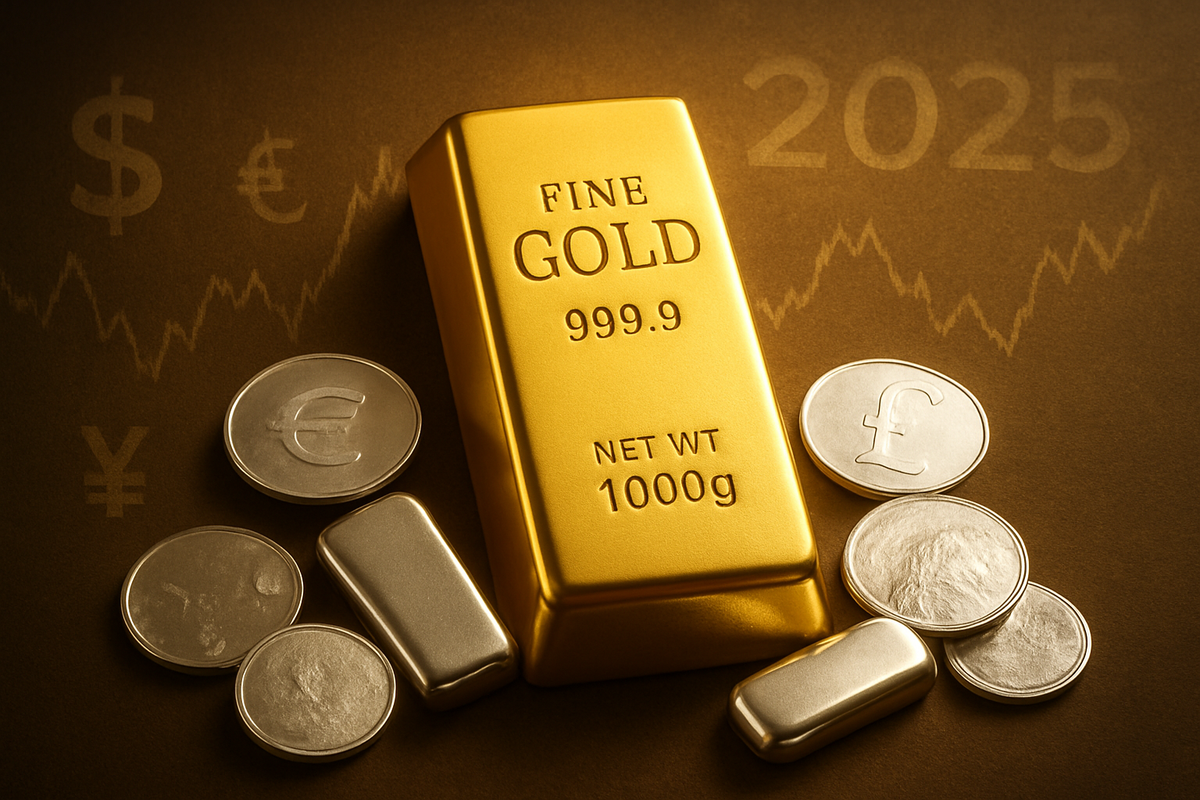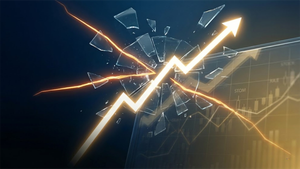
Gold continues its powerhouse run, outperforming major world currencies and stock indices through 2025, while silver and platinum shine even brighter. This remarkable performance underscores gold's enduring appeal as a safe haven and a formidable hedge against inflation in an increasingly volatile global economic landscape. With central banks aggressively diversifying reserves and institutional investors re-evaluating traditional portfolio strategies, the precious metal is undergoing a structural repricing, moving from a mere crisis hedge to a core component of long-term investment portfolios.
The sustained surge in gold prices, which has seen the metal touch unprecedented highs, signals a profound shift in investor sentiment and macroeconomic realities. As global financial markets grapple with persistent geopolitical fragmentation, burgeoning fiscal deficits, and waning confidence in conventional diversification methods, gold's consistent upward trajectory offers a beacon of stability. Its immediate implications are far-reaching, prompting a re-evaluation of asset allocation strategies worldwide and solidifying its role as a crucial safeguard against economic turbulence and currency debasement.
Gold's Unprecedented Ascent: A Detailed Look at Its 2025 Performance
The year 2025 has cemented gold's status as a top-tier asset, with the precious metal demonstrating a relentless upward trend that has left other major asset classes in its wake. As of October 30, 2025, gold was trading robustly around $3,981.47 USD per troy ounce, marking an impressive 44.95% increase from the previous year. This ascent was not without its dramatic moments, including a brief climb to an all-time high of approximately $4,300 per ounce before a natural technical correction brought it back to around $4,050.
This "powerhouse run" has seen gold futures surge approximately 30% year-to-date by August, consistently outperforming global stock markets, commodities, and traditional foreign exchange markets. By July, gold had already recorded a 26% gain in US dollar terms for the first half of 2025, mirroring its strong performance in 2024. Notably, while gold has been exceptional, its sister metals, silver and platinum, have shown even more dramatic gains, with platinum surging 75% year-to-date in 2025 and silver also experiencing significant rallies driven by factors like tariff concerns and supply shortages.
The primary drivers behind this sustained rally are multi-faceted. Unprecedented levels of institutional buying, particularly from central banks in emerging markets, have played a pivotal role. These central banks have increased their gold purchases roughly fivefold since 2022, signaling a structural shift in reserve management aimed at diversifying away from traditional reserve currencies amidst ongoing de-dollarization trends. Furthermore, a weaker U.S. dollar and an environment of lower U.S. interest rates, particularly negative real interest rates created by the Federal Reserve's monetary policy, have diminished the opportunity cost of holding non-yielding bullion, making gold significantly more attractive compared to bonds and savings.
The timeline leading to this moment has been characterized by escalating global uncertainties. Geopolitical tensions, inflationary pressures, and a general erosion of trust in fiat currencies have propelled investors towards tangible assets. Key stakeholders involved include major central banks like the People's Bank of China (PBOC) and the Reserve Bank of India (RBI), large institutional investors, and individual retail investors seeking wealth preservation. Initial market reactions have been a mix of cautious optimism and a scramble for allocation, with many financial analysts revising their price targets upwards. J.P. Morgan Research expects prices to average $3,675/oz by Q4 2025 and potentially rise toward $4,000/oz by Q2 2026, while Goldman Sachs Research anticipates $4,000 per troy ounce by mid-2026, with some forecasts even reaching $4,500-$5,000 by the end of 2026. This consensus bullish outlook underscores the market's conviction in gold's continued strength.
Corporate Fortunes: Who Wins and Who Faces Headwinds in the Golden Surge
The unprecedented surge in gold, silver, and platinum prices through 2025 has created a distinct cleavage in corporate fortunes across various sectors, minting new winners while posing significant challenges for others. The primary beneficiaries are, unsurprisingly, the companies directly involved in the extraction and trading of these precious metals.
Gold, silver, and platinum mining companies are experiencing a bonanza. Higher commodity prices directly translate into increased revenues and significantly expanded profit margins, leveraging their operational efficiencies. Giants like Newmont Corporation (NYSE: NEM), the world's largest gold miner, and Barrick Gold Corporation (NYSE: GOLD) are seeing their bottom lines swell. Agnico Eagle Mines Limited (NYSE: AEM) reported record financial results in Q3 2025, driven by higher gold prices. Smaller, exploration-focused companies such as i-80 Gold Corp. (TSE: IAU) and Surface Metals Inc. (CSE: SUR) are also seeing the economics of their projects dramatically improve. In the silver sector, Fresnillo PLC (LSE: FRES), the world's largest primary silver producer, alongside First Majestic Silver Corp. (NYSE: AG) and Pan American Silver Corp. (NASDAQ: PAAS), are capitalizing on robust silver demand, which is also bolstered by its industrial applications in solar panels and electric vehicles. Platinum miners, particularly those with stable operations in South Africa, Russia, and North America, are also thriving as platinum prices surge due to tight supply and increasing industrial demand.
Precious metals Exchange-Traded Funds (ETFs) have also emerged as clear winners, offering investors a direct avenue to capitalize on the price rally. Funds like SPDR Gold Shares (NYSE Arca: GLD) and iShares Silver Trust (NYSE Arca: SLV) have seen substantial inflows and impressive year-to-date gains. Gold miner ETFs, such as the Global X Silver Miners ETF (NYSE Arca: SIL) and Amplify Junior Silver Miners ETF (NYSE Arca: SILJ), have delivered even more magnified returns, reflecting the surging profitability of the underlying mining companies. The abrdn Physical Platinum Shares ETF (NYSE Arca: PPLT) has been a top performer, rising over 40% in 2025 by mid-year, reflecting platinum's strong market dynamics. Companies involved in precious metals recycling are also likely to see increased activity, as high prices incentivize consumers to sell existing gold and silver items.
Conversely, the elevated prices present significant headwinds for industries that rely on precious metals as raw materials, most notably jewelry retailers. Companies like Signet Jewelers (NYSE: SIG), along with other major and independent retailers, face a delicate balancing act. Soaring gold costs directly impact their product pricing, inventory management, and ultimately, their profit margins. This has led to a noticeable decline in consumer demand for high-carat gold jewelry, with global gold jewelry consumption decreasing by 19% year-over-year in Q1 2025. Retailers are adapting by offering more affordable alternatives, such as lower-karat gold, silver, or minimalist designs, and some are even introducing "Platinum Silver" options to keep pieces accessible.
Industrial users of platinum and silver also face increased production costs. The automotive industry, for instance, heavily relies on platinum and palladium for catalytic converters. While demand for platinum in this sector remains resilient, higher prices translate to higher input costs for auto manufacturers. Similarly, electronics and component manufacturers, solar panel producers, and electric vehicle component suppliers—who utilize silver for its exceptional electrical conductivity and platinum for various components—are grappling with elevated material expenses. This could put pressure on profit margins for companies like First Solar (NASDAQ: FSLR) and other major electronics firms, potentially spurring a search for alternative materials or more efficient metal-saving technologies. While large, diversified companies may have hedging strategies, the sustained high prices necessitate strategic adjustments to procurement and supply chains across these sectors.
A Shifting Paradigm: Wider Significance and Global Repercussions
Gold's sustained outperformance, alongside the remarkable ascent of silver and platinum through 2025, signifies more than just a fleeting investment trend; it reflects a profound recalibration of global financial strategies and a response to deep-seated macroeconomic and geopolitical shifts. This "golden era" is fundamentally altering broader industry trends, creating ripple effects across diverse sectors, and potentially influencing future regulatory and monetary policies.
The current rally fits squarely into a broader trend of de-dollarization and a strategic re-thinking of reserve asset composition by central banks globally. Gold's role as a safe haven and inflation hedge is amplified by persistent geopolitical risks, weakening confidence in fiat currencies, and the anticipation of Federal Reserve interest rate cuts. This has led to a "structural shift" where gold is increasingly viewed as an asset that can perform well in both "risk-on" and "risk-off" market environments, challenging traditional investment paradigms. Silver and platinum, while benefiting from similar safe-haven sentiment, are also powered by robust industrial demand. Silver, crucial for electronics, solar panels, and data centers, has significantly outperformed gold in the first half of 2025 due to persistent supply deficits. Platinum's resurgence is fueled by its essential role in automotive catalytic converters, driven by stricter emissions standards and a rebound in auto production, further compounded by a structural supply deficit.
These trends are creating significant ripple effects. For competitors in the asset management space, gold's outperformance challenges traditional investment strategies heavily weighted in conventional assets like bonds and equities, potentially prompting a re-evaluation of commodity exposure. Within the mining industry, high precious metals prices are enabling North American mining companies to engage in substantial equity financing, allowing them to de-risk balance sheets and fund sustainable growth, potentially leading to industry consolidation. Central banks, as key partners, are accelerating their gold accumulation to diversify reserves, enhancing financial stability and reducing reliance on the U.S. dollar, thereby accelerating de-dollarization. For industrial users, while increased exploration promises a more stable supply of critical minerals in the long term, persistently high prices could squeeze profit margins for luxury goods industries or temper demand.
Regulatory and policy implications are also emerging. If gold's appreciation is largely driven by persistent inflation concerns, central banks might face increased pressure to maintain tighter monetary policies or develop new tools for price stability. Trade policies, such as India's new transparent gold import quota system, highlight a regulatory push for efficiency and transparency in commodity trade, which could set precedents for other sensitive commodities. The growing share of gold in central bank reserves, now surpassing the euro and yen, suggests a fundamental re-thinking of reserve asset composition, influencing long-term global financial stability. Furthermore, companies demonstrating strong ESG commitments in mining are likely to attract continued investor interest and benefit from favorable regulatory environments.
Historically, the current precious metals rally draws parallels to the 1970s bull market, a decade marked by oil shocks, double-digit inflation, and a loss of confidence in paper money. Similarly, the 2001-2011 bull market, fueled by the tech bubble burst, 9/11, and the 2008 financial crisis, showcased gold's role as a protector of wealth during monetary excesses and geopolitical tensions. These historical precedents reinforce gold's function as a reliable hedge. While gold maintains its traditional status as the ultimate safe haven, silver offers a lower-cost entry point with potential for larger percentage gains, driven by its dual industrial and investment demand. Platinum's resurgence, particularly its indispensable role in catalytic converters and its current undersupply, cements its importance as a diversifier and a safer investment, highlighting its growing significance within the broader precious metals complex.
The Road Ahead: Navigating the Future of Precious Metals
As of October 30, 2025, the precious metals market stands at a pivotal juncture, having demonstrated extraordinary strength. The outlook for gold, silver, and platinum in the short and long term remains broadly bullish, though investors and industries must prepare for strategic pivots and adapt to emerging opportunities and challenges.
For gold, the short term (late 2025 - early 2026) may see a period of consolidation, potentially in the $4,200-$4,500 range, following its significant rally to unprecedented highs above $4,000 per ounce. Some profit-taking could lead to pullbacks, especially if geopolitical tensions ease or the U.S. dollar strengthens. However, sustained central bank accumulation—forecasted at around 900 tonnes in 2025—and continued investor interest are expected to provide strong underlying support. Long-term projections for 2026 and beyond are even more optimistic, with J.P. Morgan Research eyeing $5,055 by Q4 2026 and Morgan Stanley revising its 2026 forecast to $4,400. Goldman Sachs anticipates $4,800-$4,900 by the end of 2026, with some aggressive forecasts reaching $8,000 by 2028. This bullish outlook is underpinned by central bank diversification away from the U.S. dollar and gold's enduring role as an inflation hedge amidst persistent price pressures. Investors are advised to view gold as a long-term hedge, potentially rebalancing portfolios if their allocation exceeds 8-10%, and accumulating on dips.
Silver's trajectory through late 2025 and early 2026 is also expected to be strong, though with potential for consolidation in the $40-$60 range after reaching an all-time high of $54.47 per ounce. Its outlook is primarily driven by robust industrial demand from solar technology, electric vehicles, electronics, and AI data centers, coupled with persistent supply deficits (2025 marks the seventh consecutive year of shortfall). Long-term forecasts are highly optimistic, with Coin Price Forecast projecting $75 by the end of 2026 and $100 in 2028, potentially reaching $250 by 2037. Silver's critical role in the "green revolution" positions it for sustained demand growth. Industries reliant on silver, particularly electronics manufacturers, need to strengthen procurement flexibility and explore material alternatives due to cost pressures. Investors can explore physical silver, ETFs, and mining stocks, using options for leveraged exposure while managing its inherent volatility.
Platinum has been a breakout performer in 2025, soaring nearly 90% and hitting its highest level in over a decade. The short-term outlook (late 2025 - early 2026) suggests continued upward momentum, bolstered by the third consecutive year of structural deficit (a projected shortfall of 966,000 ounces in 2025) and resurgent automotive demand. Long-term forecasts for 2026 average around $1,550 to $1,670 per ounce, with Coin Price Forecast projecting $2,500 by the end of 2026 and potentially $5,000 by 2032. Platinum's essential role in the burgeoning hydrogen economy and its current undervaluation relative to gold are significant long-term drivers. Investors are encouraged to consider long-term positioning, particularly in physical platinum, as above-ground inventories could be depleted within three years. Mining companies, despite higher prices, face challenges from rising operational costs and declining mine supply due to underinvestment.
Overall, the market opportunities for all three metals are underpinned by persistent geopolitical and economic uncertainty, continued central bank buying, and growing industrial demand (especially for silver and platinum in green technologies). Challenges include short-term volatility, the potential impact of a stronger U.S. dollar or higher interest rates, and for mining, the ongoing struggle with supply constraints and rising costs. While short-term corrections are possible, the fundamental drivers of limited supply, robust demand, and their roles as safe havens are expected to propel precious metals higher in the years to come.
A Golden Future: Navigating the Enduring Strength of Precious Metals
The year 2025 has unequivocally marked a golden era for precious metals, with gold, silver, and platinum delivering a powerhouse performance that has significantly outshone major world currencies and stock indices. This remarkable run, culminating in gold's historic ascent to unprecedented highs, is not merely a transient market phenomenon but a reflection of profound shifts in global economic and geopolitical landscapes, solidifying the enduring significance of these tangible assets.
Key Takeaways from a Transformative Year: Gold's journey through 2025 has been nothing short of historic, repeatedly shattering price records and surging over 50% year-to-date, reaching as high as $4,381.21 per ounce by October 20. This exceptional performance is a testament to its multifaceted appeal, driven by escalating geopolitical risks, persistent U.S. trade policy uncertainties, a weakening U.S. dollar, and pervasive concerns over currency debasement and inflation. Crucially, the anticipated U.S. Federal Reserve interest rate cuts through 2025 have significantly lowered the opportunity cost of holding non-yielding bullion, further bolstering its attractiveness. A monumental shift in central bank strategies, particularly in emerging markets, has seen sustained, elevated gold purchases, with global central bank gold holdings now accounting for nearly 20% of official reserves, surpassing U.S. Treasuries for the first time since 1996. This, coupled with massive inflows into gold Exchange-Traded Funds (ETFs) and physical bars and coins from Western investors, underscores a deep-seated concern about fiscal health and debt sustainability in developed economies. Silver has mirrored gold's upward trajectory, briefly touching all-time nominal highs in October 2025, propelled by both its safe-haven appeal and exceptionally strong industrial demand from burgeoning green technology sectors. Platinum has emerged as a standout performer, soaring nearly 90% in 2025, driven by tight above-ground inventories, ongoing mine production challenges, and a resurgence in demand from both jewelry and critical industrial applications like hydrogen fuel cells.
Assessing the Market Moving Forward: Looking beyond 2025, the outlook for precious metals remains largely bullish, supported by enduring macroeconomic and geopolitical currents. Analysts, including J.P. Morgan Research and Metals Focus, predict gold will continue its upward trend, with forecasts challenging $5,000 per ounce in 2026. Silver is projected to maintain its strong performance, with Metals Focus expecting it to challenge $60 per ounce by mid-to-late 2026, and some forecasts even suggesting $70-$100 per ounce by 2030, propelled by the expanding green energy revolution. Platinum's price is expected to average $1,670 per ounce in 2026, a significant increase over 2025 levels, as market deficits are projected to persist through 2029. The underlying drivers—persistent U.S. trade policy uncertainty, declining real interest rates, and continued central bank diversification—are expected to sustain this momentum across the complex.
Significance and Lasting Impact: The exceptional performance of precious metals through 2025 signifies more than a temporary market trend; it points to a fundamental recalibration of investment strategies in an increasingly uncertain world. Gold has firmly re-established its position as the ultimate safe-haven asset and an optimal hedge against a unique combination of stagflation, recession, currency debasement, and policy risks. Its low correlation with other asset classes makes it an indispensable portfolio diversifier during times of economic instability and geopolitical stress. The accelerated central bank accumulation of gold marks a profound shift away from traditional reliance on the U.S. dollar as a primary reserve asset, indicating a long-term structural change in global financial architecture. This "secular bull market" for gold could extend for many years as countries seek to diversify and de-risk their national balance sheets. For silver and platinum, their vital roles in burgeoning green technologies, electronics, and energy applications tie their long-term value to the ongoing global energy transition and technological advancements, providing a robust demand floor independent of purely investment-driven sentiment.
What Investors Should Watch For in Coming Months: As of October 30, 2025, with gold trading around $3,981.47/t.oz, silver around $47.89/oz, and platinum having recently pulled back from its peak, investors should closely monitor several key indicators. The U.S. Federal Reserve's upcoming interest rate decisions, particularly the anticipated 25-basis-point cut in December, will heavily influence precious metals. Any shift in dovish sentiment could boost bullion. Ongoing geopolitical and trade developments, especially U.S.-China trade negotiations, will continue to drive safe-haven demand. Continued persistence of inflation will reinforce the appeal of precious metals as a hedge. The strength of the U.S. dollar, central bank purchase levels, and ETF flows will also be critical indicators. For silver and platinum, close attention to industrial demand, particularly from green energy sectors, and any changes in mine production or supply deficits will be crucial. While short-term volatility is expected, the underlying structural drivers suggest that any pullbacks represent healthy consolidations within a broader, enduring bull market for precious metals.
This content is intended for informational purposes only and is not financial advice





